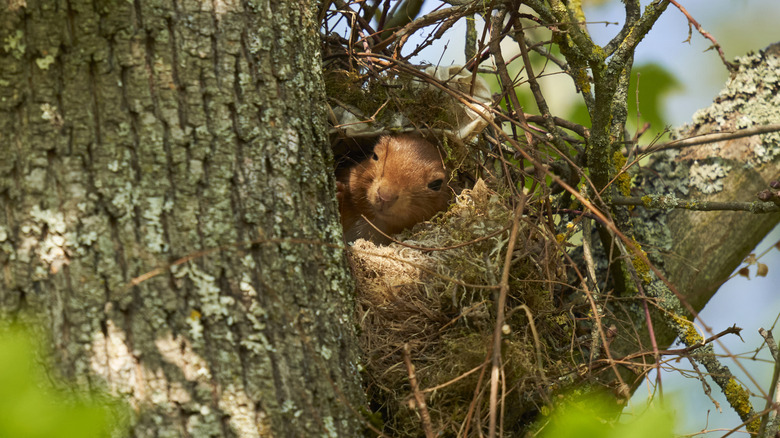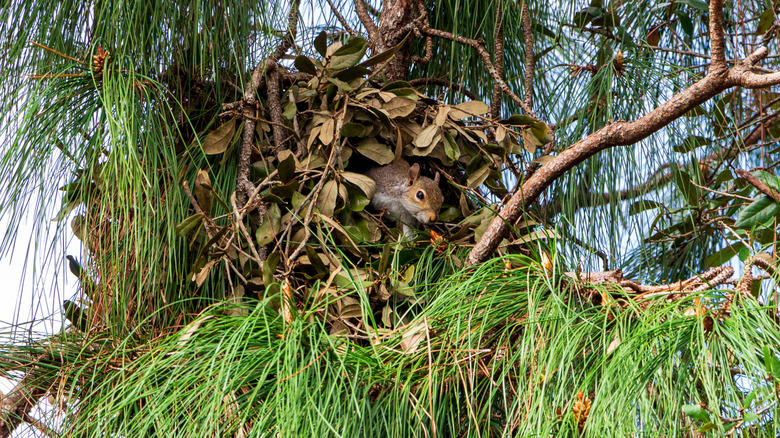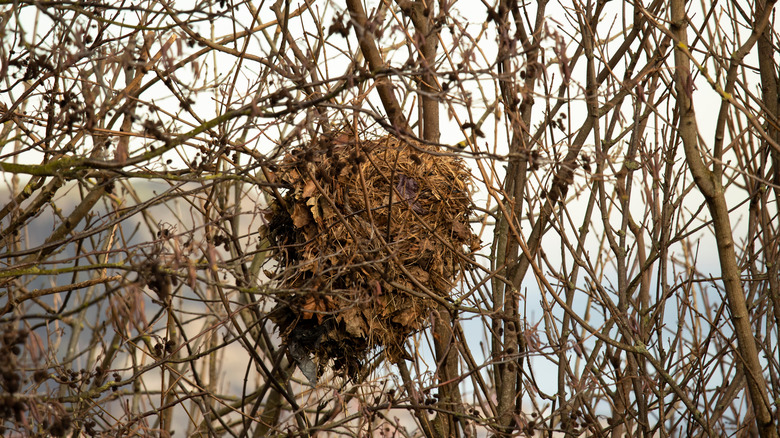How To Tell The Difference Between A Bird Nest And A Squirrel Nest
When you think of nests, you probably think of birds, but nesting isn't just for feathered fauna. There are several species of mammals that make nests, and most of them belong to the order of rodents. Many people have become familiar with rat nests by being unfortunate enough to find one in their attic, but there's another rodent whose nests often go unnoticed because they look so similar to those of birds. Squirrel nests are, like bird nests, built high up in trees, often wedged between a pair of forking branches. They are built from twigs and leaves, with a round shape. Take a quick glance at one, and you'd probably assume it belongs to a bird, but a closer inspection will reveal some key differences.
For starters, squirrel nests are technically known as dreys, and at around one to two feet in diameter, they are much bigger than most bird nests. Many people mistake them for the nests of hawks or eagles, but those birds build nests with a flat top like a platform. Squirrel dreys are round, with a secret opening facing the tree trunk. Birds also tend to build nests from sticks alone, whereas squirrels add large quantities of leaves to their dreys. So, if you see a nest that's large and made of mostly leaves, you're probably looking at a squirrel drey. The differences in size, shape, and construction materials all come from the fact that squirrels use their nests very differently than birds do.
How, and why, squirrels build dreys
Like birds, squirrels build nests to protect their offspring during the early stages of life. Squirrels can give birth to multiple litters in a single year, just as many birds do, and like birds, they need a nest to protect their vulnerable young ones from predators. However, whereas birds tend to abandon their nests as soon as their offspring are fully-fledged, squirrels may make use of their dreys all year, like a home base in which they can sleep in safety.
The only time of year when squirrels might abandon their dreys is in winter, as they often seek more insulated spaces, like hollows within tree trunks, or, much to many people's chagrin, household attics. When squirrels move into tree hollows, they often turn them into a nest of sorts as well, lining them with leaves, just as they line their dreys. However, sometimes squirrels use their dreys through winter, with the mother and her offspring huddling together within them for maximum warmth.
Despite their often shaggy outward appearance, squirrel dreys are built with an impressive degree of care and precision. The squirrel first creates a framework of interwoven twigs before filling it out with foliage. In urban areas, squirrels will sometimes use human trash and litter, like discarded bags. The finished drey is put together tight enough to be waterproof, making it into a safe haven in the event of rain or snow.
Dreys differ between squirrel species
Just as different types of birds build different-looking nests, different species of squirrel build different-looking dreys as well. You can actually tell which kind of squirrel made a given drey just by looking at the materials it is made of. Consider, for example, the eastern gray squirrel and the red squirrel, the two most common species of squirrel in the United States. Eastern gray squirrels tend to build their dreys in deciduous trees, which are trees that have broad, flat leaves that change with the seasons. Oak trees are a prime example, beloved by gray squirrels for the acorns they provide.
In fact, there is a strong correlation between drey design and the diet of a squirrel, since the rodents tend to build their dreys in the same trees they get their primary food source from. While eastern gray squirrels love acorn-bearing oaks, red squirrels prefer to eat pinecones, and thus, they build their dreys in pines or other coniferous trees, shredding strips of the bark to use as a building material. Even flying squirrels build dreys, although they are some of the hardest to locate because flying squirrels are nocturnal. Their nests tend to be very small, built in conifers and made from shredded bark patched with moss and lichen. When temperatures get cold, as many as 10 flying squirrels pack inside for warmth, turning the drey into one big cuddle puddle.


